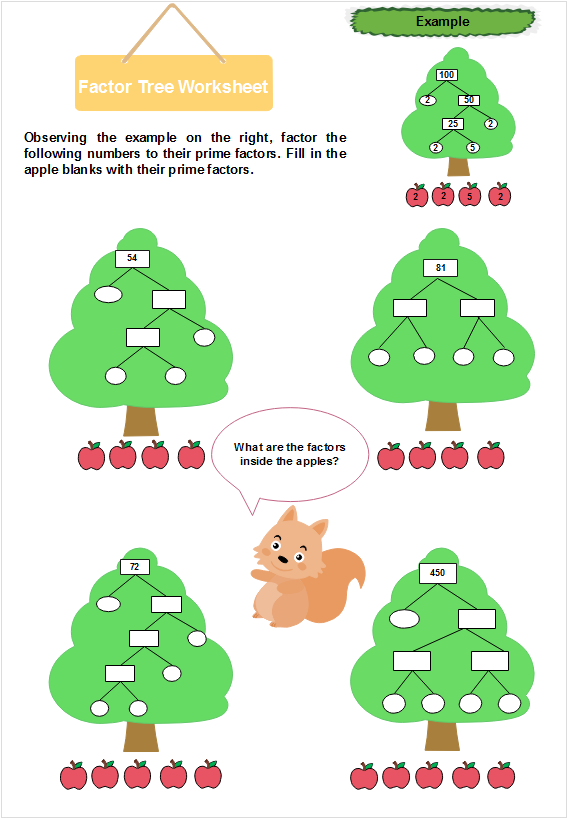CONTENT SUMMARY
Each place on the place value chart represents a power of ten. As we move left of the decimal place, the numbers increase in value. The opposite happens when we move right of the decimal point. All digit to the left of the decimal point are whole numbers. Digits to the right of the decimal point are fractional numbers. Every digit has three values: the place, the face and the actual or true value. The place times the place gives the actual value.
The factors of a number are all the numbers that are able to completely divide a given number without leaving a remainder. One (1) is a universal factor.
Students will review what factors are and provide the factors of given numbers. Tell what prime numbers are, and provide a definition for same.
Find a working definition for prime factors and prime factorization.
EXPLORE
Today we will be finding the prime factors of a number by way of factorization.
Take a look at the chart below. This is what a factor tree looks like.
|
Numbers |
Factors |
Prime factors |
|
18 |
|
|
|
30 |
|
|
2. Use factor trees to derive at the prime factors of the following:
24 16 60
W 3 Write true or false at the end of each statement below.
(a) 2 is the only even prime number. ________________________
(b) A number with only two factors is a prime number. _________
(c)
There are 6 prime numbers between 1 and 14. _____________
Grade 6 Mathematics Lesson Plan (5E Model)
Theme: Numbers – Exponents
Focus Question: How do I write numbers in the different number system?
Duration: 1 hour
Objectives:
-
Read, write, and use numbers using the principle of place value in the Hindu-Arabic system of numeration.
-
Write numbers in exponential form.
ENGAGE (10 mins)
Activity: Number Detective!
-
Present the number 10,000 on the board and ask:
"Can anyone think of a different way to write this number using repeated multiplication?"
-
Prompt students until someone guesses or you guide them to:
10 × 10 × 10 × 10 = 10,000
-
Introduce the term exponents and write 10⁴ as a shortcut.
-
Show Hindu-Arabic digits (0–9) and ask:
“What system are we using when we write 10,000 with these digits?”
(Answer: Hindu-Arabic numeration)
STEM Link:
Connect this to computer science, where large numbers are often stored in powers of 2 (e.g., 2⁸ = 256). Ask:
“Why might computers or engineers prefer exponents when dealing with large numbers?”
EXPLORE (15 mins)
Activity: Power Builders
-
In pairs, students are given base numbers and asked to:
-
Multiply the base by itself for a given number of times.
-
Record the result in exponential and expanded form.
-
| Base | Exponent | Exponential Form | Expanded Form | Value |
|---|---|---|---|---|
| 2 | 3 | 2³ | 2 × 2 × 2 | 8 |
| 5 | 2 | 5² | 5 × 5 | 25 |
| 10 | 5 | 10⁵ | 10×10×10×10×10 | 100,000 |
-
Walk around and assist as needed.
Differentiation:
-
Tier 1 (Support): Use base 2 or 3 only, smaller exponents.
-
Tier 2 (On Level): Base numbers 2–10, exponents up to 4.
-
Tier 3 (Extension): Work with larger bases and exponents; e.g., 12⁴.
EXPLAIN (10 mins)
Mini-Lesson + Guided Notes
-
Define and explain:
-
Base: The number being multiplied.
-
Exponent: How many times the base is multiplied by itself.
-
Exponential form: A shorter way to write repeated multiplication.
-
-
Revisit the Hindu-Arabic numerals and their value based on place value (e.g., 3,000 = 3 × 10³).
Visual Aid:
Use a place value chart alongside powers of 10 (e.g., 10⁰, 10¹, 10²...) to help them link place value and exponential form.
ELABORATE (15 mins)
Activity: Exponential Match & Build Game
-
Provide students with cards:
-
Some with standard numbers (e.g., 1,000),
-
Some with expanded form (10 × 10 × 10),
-
Some with exponential form (10³).
-
-
Students work in groups to match cards correctly and explain reasoning.
-
Bonus: Groups build number towers using LEGO blocks or paper cubes to represent powers (e.g., 2⁴ = 16 blocks).
STEM Extension:
Discuss how scientists use exponential notation in real-world situations like:
-
Distances in space (light years),
-
Population growth,
-
Computer memory (e.g., kilobytes, megabytes).
EVALUATE (10 mins)
Three-Tiered Exit Ticket (Differentiated Assessment)
| Tier | Task | Sample |
|---|---|---|
| Tier 1 (Support) | Write the exponential form for: 10 × 10 = ? | Answer: 10² |
| Tier 2 (On Level) | Match standard form with exponential form: 1,000 = ? | Answer: 10³ |
| Tier 3 (Advanced) | Write and evaluate: 2⁵ and 5² + 3³ | Answer: 32 and 25 + 27 = 52 |
Teacher Checklist:
-
Did students correctly identify base and exponent?
-
Did students relate place value to exponential form?
-
Did students participate actively in collaborative tasks?
Materials Needed:
-
Chart paper/whiteboard
-
Place value chart
-
Exponent flashcards
-
STEM visual aids (e.g., computer chip diagram, scientific notation examples)
-
Number blocks or LEGO (optional)








Hi miss. Just finished. The work was awsome. I really loved it.
ReplyDelete